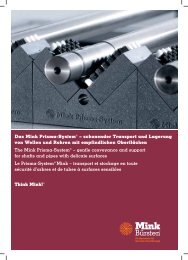Transmission Chain catalogue
Transmission Chain catalogue
Transmission Chain catalogue
Create successful ePaper yourself
Turn your PDF publications into a flip-book with our unique Google optimized e-Paper software.
Precision Roller <strong>Chain</strong>,<br />
Parts and Connecting Links<br />
The Renold precision steel roller chain is a<br />
highly efficient and versatile means of<br />
transmitting mechanical power, which, in the<br />
field of industrial applications, has almost<br />
completely superseded all other types of chain<br />
previously used.<br />
The illustration below shows component parts<br />
of the outer link and of the inner link of a<br />
Renold simple roller chain.<br />
As illustrated, the Renold precision steel roller<br />
chain consists of a series of journal bearings<br />
held in precise relationship to each other by<br />
the constraining link plates. Each bearing<br />
consists of a bearing pin and bush on which<br />
the chain roller revolves. The bearing pin and<br />
bush are case hardened to allow articulation<br />
under high pressures, and to contend with the<br />
load carrying pressures and gearing action<br />
imparted via the chain rollers.<br />
All chains are classified according to pitch<br />
(the distance between the centres of adjacent<br />
bearing pins), roller diameter and width<br />
between inner plates. Collectively, these<br />
dimensions are known as the gearing<br />
dimensions, as they determine the form and<br />
width of the sprocket teeth.<br />
Standard links<br />
The chain parts and connecting links illustrated<br />
are only indicative of the types available.<br />
Please refer to the appropriate product page<br />
for the parts relevant to individual chains.<br />
No. 4<br />
Inner Link (BS/DIN)<br />
Roller Link (ANSI)<br />
These are complete assemblies for use with all<br />
sizes and types of chain. The unit consists of<br />
two inner plates pressed on to the bushes<br />
which carry the rollers. (Inner links for use with<br />
bush chains have no rollers).<br />
No. 107<br />
Outer Link - Press Fit (BS/DIN)<br />
Riveting Pin Link - Press Fit (ANSI)<br />
For use with all sizes and types of chain where<br />
optimum security is desired. The link is supplied<br />
with bearing pins riveted into one outer plate.<br />
The other outer plate is an interference fit on<br />
the bearing pins, the ends of which should be<br />
riveted over after the plate is fitted.<br />
Press fit connecting links should only be<br />
used once; new links must be used to replace<br />
dismantled links. (See 'Riveting <strong>Chain</strong> Endless'<br />
for full instructions).<br />
No. 11<br />
Connecting Link - Slip Fit<br />
(BS/DIN/ANSI)<br />
No. 26<br />
Connecting Link - Slip Fit<br />
(BS/DIN/ANSI)<br />
No. 58<br />
Connecting Link - Press Fit<br />
(BS/DIN/ANSI)<br />
Outer plate<br />
Bearing pin<br />
Roller<br />
Inner plate<br />
Outer plate<br />
A connecting link supplied with two connecting<br />
pins riveted into the outer plate. The outer<br />
plate is a clearance fit on the connecting pins<br />
and is secured in position by a split pin through<br />
the projecting end of each connecting pin.<br />
Used on short pitch chains only. Supplied with<br />
two connecting pins riveted into the outer<br />
plate, the clearance fit connecting plate being<br />
secured by means of a spring clip, No. 27,<br />
which snaps into the grooves in the pins.<br />
The standard connecting link for ANSI series<br />
detachable chains, also used on riveted chains<br />
where high speeds or arduous conditions are<br />
encountered. Supplied with two connecting<br />
pins riveted into the outer plate, the other<br />
outer plate being a press fit onto the pins and<br />
secured by split pins after assembly.<br />
Press fit connecting links can only be used<br />
once; new links must always be used to replace<br />
dismantled links.<br />
Renold <strong>Transmission</strong> <strong>Chain</strong> Catalogue I 5<br />
Inner plate<br />
Bush<br />
Cranked links<br />
Apart from the specialised chains where the<br />
cranked link is an essential design feature,<br />
cranked links are used only where the chain<br />
length must be an odd number of pitches. This<br />
practice is not recommended; all drives should,<br />
wherever possible, be designed with sufficient<br />
overall adjustment to ensure the use of an<br />
even number of pitches throughout the chain.<br />
DO NOT USE CRANKED LINKS ON IMPULSIVE,<br />
HIGHLY LOADED OR HIGH SPEED DRIVES.<br />
No. 12<br />
Cranked Link - Slip Fit (BS/DIN)<br />
Offset Link - Slip Fit (ANSI)<br />
A single link with cranked plates pressed onto a<br />
bush and roller assemble at the narrow end. A<br />
clearance fit connecting pin (No. 128) is fitted<br />
at the wide end and is secured by a split pin.<br />
No. 30<br />
Cranked Link Double (BS/DIN)<br />
Two Pitch Offset Link (ANSI)<br />
Double cranked links are available for most sizes<br />
and types of chain. The unit consists of an<br />
inner link (No. 4), with cranked links retained<br />
permanently in position by a riveted bearing pin.<br />
Screw operated extractors break chain by forcing<br />
the Renold end softened<br />
bearing pins out of the<br />
outer link plates. For<br />
other brands of chain,<br />
the rivet swell must<br />
first be ground away.<br />
Section 1



